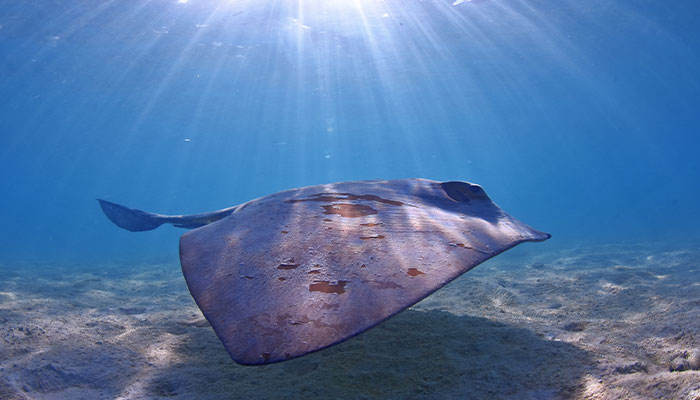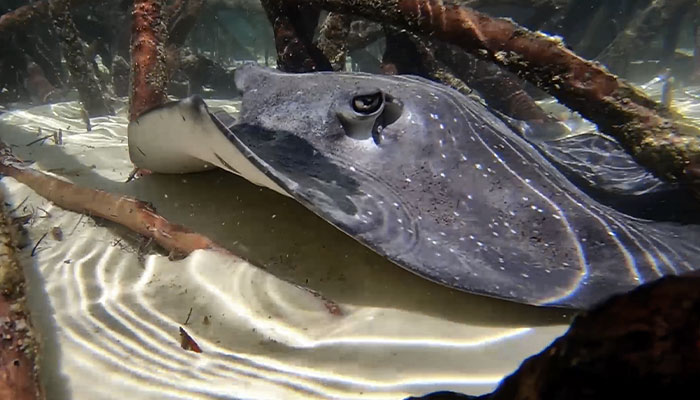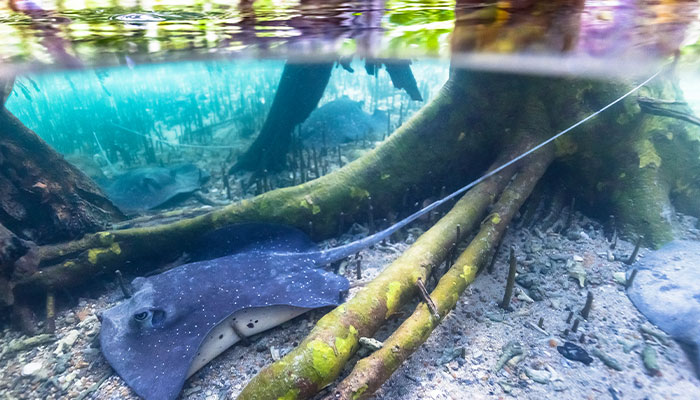Scientists always thought stingrays were silent – but new research has shown at least two species of stingrays can produce sounds voluntarily, possibly as a warning response to perceived threats.
The research formally confirms tales that commercial fishers have told for years.
Scientists from Sweden, Spain and Australia have documented three videos of this phenomenon in a paper recently published in the journal Ecology.
This remarkable insight into stingray behaviour emerged publicly when scientists were alerted to online video footage of stingrays making clicking sounds – and then found underwater footage of such incidents, recorded by three different people.
The ray looked to be intentionally making the sounds in response to the snorkeller coming close.
The first video, recorded by photographer and biologist J. Javier Delgado Esteban around Magnetic Island off Townsville in 2018, features a juvenile mangrove whipray (Urogymnus granulatus) that, on becoming separated from the rest of its group, produced a series of loud clicks.
Dr Joni Pini-Fitzsimmons of Macquarie University has spent years studying stingray groups, so when fellow marine scientist Dr Lachlan Fetterplace of the Swedish University of Agricultural Sciences discovered Delgado Esteban’s YouTube video featuring the odd sounds, he alerted Pini-Fitzsimmons.
Pini-Fitzsimmons says she was amazed when she saw the footage.
“The ray looked to be intentionally making the sounds in response to the snorkeller coming close, so it may be a distress signal. These stingrays are also social, so it might also have been a warning to others nearby or calling for help.”
Collecting video evidence
Pini-Fitzsimons says that the unusual footage was on her mind when, six months later, she saw Instagram footage taken in Indonesia featuring an adult of the same species making very similar clicking sounds.

Soundscapes: A cowtail stringray around Heron Island, Queensland. Picture credit: John Gaskell
“I immediately contacted the diver, Philip Christoff, who sent me his original footage,” she says. “I knew then that we were onto something.”
Meanwhile, Delgado Esteban contacted Dr Barbara Wueringer, an Adjunct Fellow at Macquarie University’s School of Natural Sciences and Principal Scientist at Sharks and Rays Australia, asking if she had seen anything like the clicking juvenile mangrove whipray he had recorded.
Wueringer, who is based in Cairns, says that for more than a decade she had heard stories about stingray noises from commercial fishers who dived in the remote waters of northern Australia.
“These guys spent a huge amount of time underwater in remote areas, their jobs and their lives depend on them being excellent observers of sea life, and they would tell me that the stingrays were really loud – but their focus was on fishing, they didn’t have any recordings of this,” Wueringer says.
Wueringer asked around – and marine biologist Johnny Gaskell showed her video he had recorded while snorkelling, of an entirely different species to the whiprays, making very similar sounds.
Gaskell’s recording showed clicking sounds made by an adult cowtail stingray (Pastinachus ater), another species of stingray often seen in groups, around Heron Island on the Great Barrier Reef in 2017 – and Wueringer shared this with Fetterplace and Pini-Fitzsimmons.
“We couldn’t believe it. Not only did we have a behaviour no one had formally described yet, but we had two species making these sounds,” says Pini-Fitzsimmons.
Searching for any other evidence, Dr Fetterplace found just one mention in the literature of stingrays actively making sounds, a 1970 report on captive cownose rays (Rhinoptera bonasus) in the western North Atlantic ocean, which produced short, sharp clicks when forcefully prodded.
Safety as sound-making lets rays just keep swimming
Pini-Fitzsimmons says that it’s unclear exactly how stingrays produce sound, as they don’t have anything resembling vocal cords.

Listen up: Findings suggest some elasmobranchs may use sound to communicate with each other. Picture credit: John Gaskell
However each of the videos show that at the same time as the sound, the stingray made rapid jaw movements, and there were contractions in the stingray’s gill openings and their spiracles (openings behind the eyes that help stingrays breathe while buried under sand).
“We suspect the clicks are made either by quickly expelling water through their spiracles, or through some other internal mechanism,” she says.
We think they might have been responding to danger by gathering in a group.
The click sound may add to the list of social behaviours used by elasmobranchs (the group that includes rays, sharks and skates) to communicate with other members of their species, such as tail-slapping and popping by sharks, or in stingrays – biting, chasing and shoving other rays.
Unlike these behaviours though, clicks can be made by a stingray that is swimming away from a dangerous situation, without sacrificing speed.
Response to sound seen – but not heard
While almost 990 bony fish species are known to actively produce sounds, this is the first evidence of voluntary active sound production by any elasmobranch species.

Discoveries: A juvenile mangrove whipray was filmed producing loud clicks on becoming separated from its group. Picture credit: J. Javier Delgado Esteban
Research exploring the hearing of elasmobranchs shows both sharks and rays can hear low-frequency sounds and may change their behaviour in response, either by fleeing or by approaching the source of certain sounds.
The researchers found that the sound frequencies of the clicks would be within normal stingray hearing range – but would also be in the hearing range of known stingray predators, blacktip reef sharks (Carcharhinus melanopterus) and sharptooth lemon sharks (Negaprion acutidens).
This suggests some elasmobranchs may use sound to communicate with each other – and may also be communicating with their known predators.
Mangrove whiprays and cowtail stingrays are both social species that often feed and rest in groups to deter predators.
Delgado Estaban noted that after filming the juvenile mangrove whipray at Magnetic Island, he observed other juveniles gathering around the click-producing ray, apparently responding to the sound.
“We think they might have been responding to danger by gathering in a group,” says Pini-Fitzsimmons.
Pini-Fitzsimmons says that this study shows that people’s videos of wild animals can make a valuable contribution to our understanding of the natural world – and the team hope that more recordings of stingray sound-making will now emerge.
“That we only just realised that these commonly encountered stingrays are making sounds demonstrates, once again, how little we know about the oceans,” says lead author, Dr Lachlan Fetterplace.
Dr Joni Pini-Fitzsimmons is an Honorary Postdoctoral Associate at Macquarie University.
Dr Barbara Wueringer is an Adjunct Fellow in the





